Modern businesses rely heavily on their data centers for critical operations, application hosting, and secure storage. However, outdated infrastructure can slow down performance, increase costs, and expose your organization to unnecessary risks. Knowing when to upgrade your data center infrastructure is essential for maintaining efficiency, scalability, and security.
At D2D IT Services, we specialize in data center modernization to help organizations improve reliability and optimize costs. Below are 10 signs that it may be time to upgrade your data center.
1. Aging or Outdated Hardware
If your servers, storage devices, or networking equipment are more than 5–7 years old, they could be slowing down operations and consuming excessive power. Modern hardware offers higher efficiency and longer lifecycles.
2. Rising Maintenance Costs
When maintenance bills for outdated equipment exceed the cost of an upgrade, it’s a clear signal to modernize. Third-party maintenance may help temporarily, but upgrading ensures long-term savings.
3. Frequent Downtime and Outages
If your business is experiencing repeated system crashes, network issues, or storage failures, your infrastructure may no longer support your operational demands.
4. Poor Scalability
Growing businesses need infrastructure that scales easily. If adding users, applications, or storage is slow and costly, it’s time to move toward a scalable solution.
5. Limited Energy Efficiency
Older systems consume significantly more energy, driving up costs. Upgrading to modern infrastructure not only improves performance but also supports eco-conscious IT strategies.
6. Inability to Support Modern Applications
Modern applications require higher processing power, storage, and networking speeds. If your current infrastructure struggles with virtualization, cloud workloads, or AI-powered tools, it’s time for an upgrade.
7. Cybersecurity Risks
Outdated systems often lack the latest security features and patches, making them vulnerable to cyberattacks. New infrastructure provides advanced safeguards against evolving threats.
8. Compliance Challenges
If your infrastructure can’t support compliance with regulations like HIPAA, GDPR, or FedRAMP, it poses serious business risks. Upgrading ensures compliance readiness.
9. Cloud Integration Limitations
Hybrid and multi-cloud strategies are the future of IT. If your data center cannot integrate seamlessly with cloud environments, you risk falling behind.
10. Business Growth Outpacing IT Capacity
If your IT team is constantly troubleshooting and struggling to meet business demands, it’s a strong indication your infrastructure has reached its limit.
Benefits of Upgrading Your Data Center
Improved performance and uptime
Reduced operational costs
Enhanced security and compliance
Greater scalability and flexibility
Support for cloud and emerging technologies
At D2D IT Services, we help organizations transition to modern, scalable, and secure infrastructures designed to handle today’s challenges and tomorrow’s growth.
1. How often should businesses upgrade their data center infrastructure?
Most organizations upgrade every 5–7 years, depending on business needs, hardware lifecycle, and technology advancements.
Delaying upgrades can lead to security vulnerabilities, downtime, rising costs, and inability to scale with business growth.








